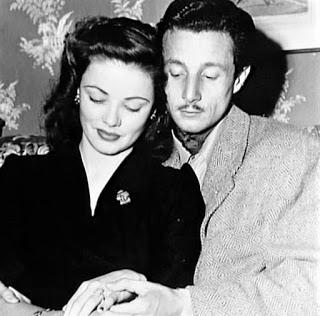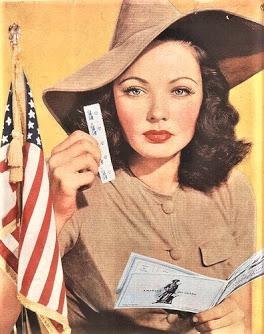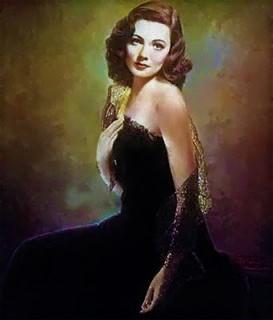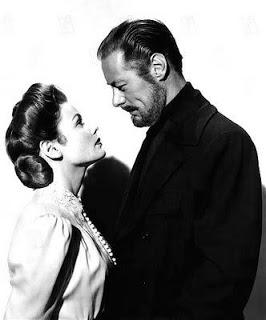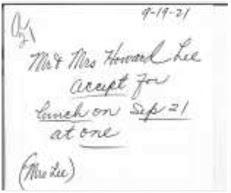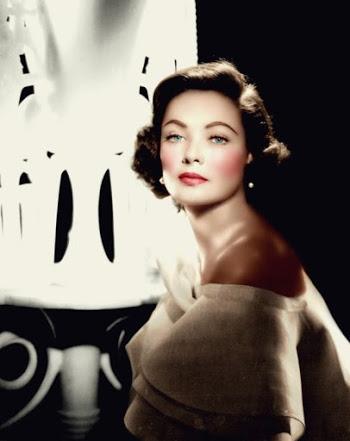Gene Tierney would admit that before she married Oleg Cassini, “I dated dozens of young men, had fun with all, made commitments to none.” This crush of eligible fellows ran the gamut from Howard Hughes to Desi Arnaz, but when she met Cassini at the end of 1940 she was instantly smitten. By their third date the couple was talking marriage. Though her parents and the studio were united in opposition, the couple broke the impasse when they eloped to Las Vegas in June 1941.
Gene marries Oleg Cassini on June 1, 1941
Oleg Cassini was born in Paris in 1913, son of an Italian Countess and a Russian aristocrat. Raised in Florence, he first worked at his mother’s salon there, later opened his own shop in Rome, then moved to Paris and the house of Patou. The family immigrated to the U.S. in 1936, with Oleg working at various design houses in New York, including his own, before making his way to Hollywood. Gene’s decision to elope was driven by passion - and something more. Not long before she and Cassini rushed to Las Vegas she had come face to face with some ugly truths about her father. All her life Gene had looked up to the man. She sought his advice and gladly accepted his management of her career. But now Howard Tierney threatened to have his daughter committed if she went ahead with her marriage plans. While this threat was still looming, she discovered that her father was carrying on a very public love affair with a friend of the family. Then, once Gene and Cassini were married,Mr. Tierney threatened to have the marriage annulled. This was the last straw. Gene demanded that the trust into which her income flowed be dissolved and that her earnings be paid to her. Unfortunately, nothing came of this for, as Gene would find out, Howard Tierney had misspent nearly everything in the account. Her estrangement from her father only escalated when her parents divorced and he remarried.

Son of Fury (1942), Gene and Ty Power
Though her personal life had become chaotic, Gene’s career was moving along at a steady pace. She began work on Son of Fury: The Story of Benjamin Blake (1942) once The Shanghai Gesturewrapped. This was Gene’s first role opposite Fox’s top leading man, Tyrone Power. She would portray Eve, a native girl Power’s Benjamin Blake encounters in Polynesia and to whom he returns once his name has been cleared and his birthright restored back in England. Fox promoted the picture with a marketing campaign that made the most of its two beautiful stars. On November 10, 1941 Life magazine featured Gene on its cover. Nine days later she celebrated 21st birthday. A few weeks after that, the Japanese attacked Pearl Harbor, drawing the U.S. into World War II. Cassini soon enlisted and left for camp in Kansas. Son of Fury was released in late January 1942. It was a frantic time, yet Gene continued to make film after film. Next came a romantic comedy with Henry Fonda, then two World War II pictures. In the meantime, she began making appearances at war bond rallies.
Supporting the war effort
While she had already worked with some fine directors – the likes of Lang, Ford, von Sternberg and Wellman – 1943 would bring the chance to work with a filmmaker who had perfected, if not invented, romantic comedy, Ernst Lubitsch. In Heaven Can Wait, his gentle period comedy, Gene portrays the tolerant wife of an incorrigible roué (Don Ameche) whose story is told as he reviews his past with the devil at the end of his life. It was her best film to date. Released in August 1943, Heaven Can Wait went on to be nominated for three Oscars including Best Picture and Best Director. And it would be the only film Gene would make in 1943. The reason for her absence from the screen was to be a happy one: she was pregnant with her first child. However, one night early in her pregnancy Gene contracted the German measles when she made her only appearance at the Hollywood Canteen. Although doctors had reassured Gene when she came down with the virus, her daughter, Daria, was born profoundly mentally and physically handicapped as a result of her mother’s illness. Bizarrely, Gene would learn how she contracted the virus at a tennis party sometime later. There, a fan approached her for an autograph and told her that although she had been under quarantine with German measles that night, she had gone out to the Hollywood Canteen anyway. She had to, she said, because Gene was her favorite actress and she wanted to meet her. Gene turned and walked away. She would later write, “After that I didn’t care if I was ever again anyone’s favorite actress.” Ironically, most of her best roles – and even an Oscar nomination – lay just ahead.Portrait of Laura, a photo softened with brush strokes
Gene's next film, her best known and well-loved, had a rocky route to the big screen. The production of Laura (1944), one of the greatest of stylish noirs, started and stopped twice under its original director Rouben Mamoulian. When he was replaced by Otto Preminger, the production started all over again. Jennifer Jones, Hedy Lamarr and Roz Russell had all turned down the role of Laura before Gene was given the part. John Hodiak had been considered before Dana Andrews was chosen. Zanuck had favored Laird Cregar for the role of Waldo Lydecker, the film's pivotal character, before Clifton Webb was cast. Under Preminger, all elements finally came together and Laura, with the additional benefit of David Raksin's lovely score, emerged a classic. Nominated for five Oscars, it won for its cinematography, and is now ranked #4 on the AFI's list of the 10 all-time greatest mystery films. Gene was reluctant to take credit for Laura's success, judging her own performance as not "much more than adequate." She felt viewers were responding to a "dreamlike" aspect inherent in the character. But Oleg Cassini would recall that Laura began filming only months after Daria's birth, when he and Gene were still overwhelmed and grieving. He believed Gene's reaction to this personal tragedy informed her performance, "There was a ghostly quality, an evanescence, to both Laura and Gene." According to her husband, her remoteness did not subside.
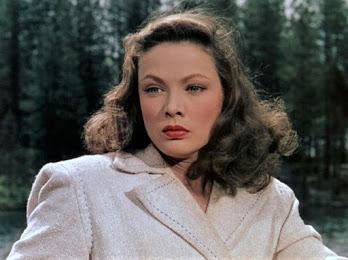
Gene as "a marvelous medusa" in Leave Her to Heaven
Laura gave Gene the breakthrough she needed; now she was a star. Her next outing was a World War II drama co-starring with John Hodiak: A Bell for Adano (1945), based on John Hersey's 1944 Pulitzer Prize-winning novel. Bosley Crowther of the NY Times called it a near-perfect "picturization of Mr. Hersey's book" and credited Gene with a "sensitive" performance. But it would be the film that followed that would reaffirm her arrival at the pinnacle of her career. With Leave Her to Heaven (1945), directed by John M. Stahl, she proved she could carry an entire picture - a surreal three-strip-Technicolor noir, at that - nearly on her own. Cornell Wilde, Jeanne Crain, Vincent Price, Darryl Hickman and the rest of the cast provide capable support. And Leon Shamroy's rich, saturated, Oscar-winning color images of sprawling vistas and cozy interiors intensify the impact of this mesmerizing and disturbing cinematic experience. However, as Michael Koresky points out, "it's all exquisite, but perhaps nothing compares to the otherworldly visual effect that is Gene Tierney" as a "seamlessly beautiful predator." Her chilling portrayal of a perfect beauty with a poisonous heart and a Machiavellian mind brought her a Best Actress Oscar nomination. The film received a total of four Oscar nominations including Shamroy's win. Martin Scorsese has declared that Leave Her to Heaven is one of his favorite films and that he considers Gene Tierney one of the most underrated actresses of her era. Observing that her beauty seems a kind of mask, he notices her "fragility as an actress." No doubt aware of her personal difficulties, he says, "You watch her on camera throughout her career, and you can see a genuine, very moving internal drama being played out."Joseph L. Mankiewicz's Rebecca-esque gothic mystery Dragonwyck came next, in 1946. Then a prestige picture, The Razor's Edge, directed by Edmund Goulding and heralding Tyrone Power's return from World War II service. An adaptation of Somerset Maugham's novel about a disillusioned young man (Power) who chooses the road less taken, the film also featured Anne Baxter, who won a Supporting Actress Oscar for her performance, Clifton Webb, John Payne and Herbert Marshall. The next year, 1947, brought Mankiewicz's charming The Ghost and Mrs. Muir, with Gene opposite Brit leading man Rex Harrison. It is an ethereal tale of a widow who finds more pleasure in the company of the ghost of a sea captain who haunts her home than she does with the men she knows in earthly life. Although it was not Gene's final film of the decade, it would be her last true classic of the 1940s. Gene Tierney and Rex Harrison
She had made seven solid films in a row over four years, beginning with Heaven Can Wait, and was now a reliably bankable Hollywood star. But her personal life was collapsing. The decision to place Daria in an institution had been made with extreme difficulty. Oleg's career as a Hollywood designer had been derailed when he married Gene and his screen credits dwindled; almost all of them amounting to "Costumes: Miss Tierney." There were break-ups and reconciliations. With break-ups came romances, in Gene's case a serious relationship with John F. Kennedy, then an ex-Navy Lieutenant about to go into politics. With reconciliation came another child, Christina, a healthy girl born in 1948. But the marriage continued to flounder until 1952 when a final split brought divorce. By this time Gene's career was waning. At the same time, Hollywood was in a state of flux that began earlier in the post-war era. Movie attendance began to drop in the late '40s, a reflection of changing tastes and the impact of two consequential events. A 1948 Supreme Court ruling forced the studios to divest themselves of their theater chains and so, without guaranteed outlets for their movies, the studios were making fewer films. And then television arrived.After The Ghost and Mrs. Muir in 1947 the only real bright spot on Gene Tierney's filmography for many years was Night and the City (1950) a terrific noir from Jules Dassin co-starring Richard Widmark. Of course, there were roles she missed out on, like Dorothy McGuire's role in A Tree Grows in Brooklyn, because of pregnancy, and those she turned down, like Grace Kelly's part in Mogambo. She would later clarify any misunderstanding about her eventual absence from the screen, "My departure from Hollywood was described as a walk-out. No one understood that I was cracking up." There had been a distressing break-up of her serious romance with Prince Aly Khan, Rita Hayworth's ex-husband. And then, after struggling to remember and deliver her lines on The Left Hand of God (1955), Gene broke down. She would spend much of the rest of the decade in and out of mental health facilities.As with Frances Farmer and Vivien Leigh before her, her treatment would include electroshock therapy. In today's terms, it is believed that her condition was likely a bipolar disorder.
RSVP for lunch...at the White House
Gene returned to film when she accepted a supporting role in Otto Preminger's star-studded production of Advise & Consent (1962). An adaptation of Allen Drury's 1959 Pulitzer Prize-winning bestseller about Senate confirmation hearings for a fictional Secretary of State. Among the cast: Henry Fonda, Charles Laughton, Franchot Tone, Lew Ayres and Walter Pidgeon. Gene took the role of a prominent DC society hostess. Filming began in the fall of 1961 and involved location shooting in and around Washington. As a welcoming gesture, President Kennedy invited the cast to a White House luncheon on September 21, 1961. Gene was graciously seated next to the President - on one side - and next to her new husband, oil tycoon Howard Lee, on the other. It was the last time Gene and would see Jack Kennedy. She would never make a full return to acting. Her permanent home would be with Howard in Houston, Texas. Gene Tierney seemed to have gained insight and some inner peace, and she would eventually claim, "I have a role now that I think becomes me. I am a grandmother."
Life is a little like a message in a bottle, to be carried by the winds and the tides - Gene Tierney
End of Pt. 2
Link to Pt. 1
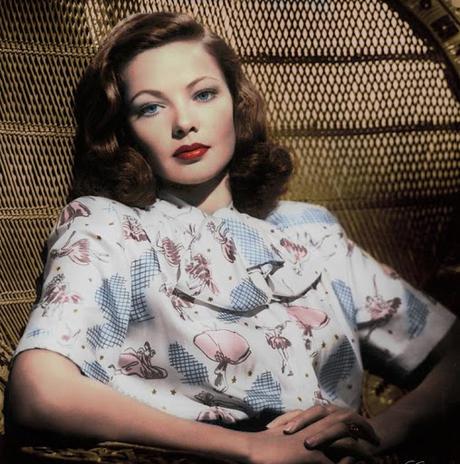 Celebrating the 100th anniversary of Gene Tierney's birth on November 19, 1920
Celebrating the 100th anniversary of Gene Tierney's birth on November 19, 1920
